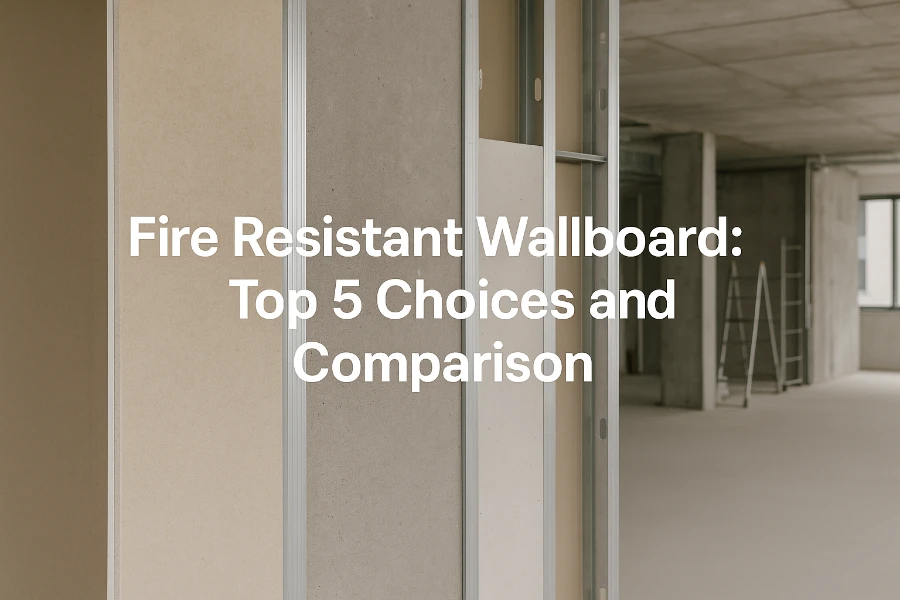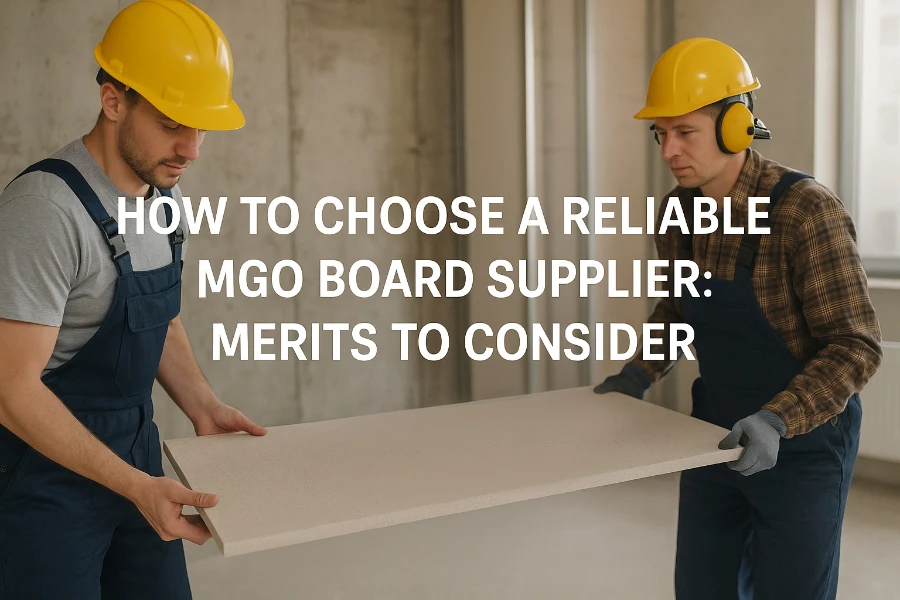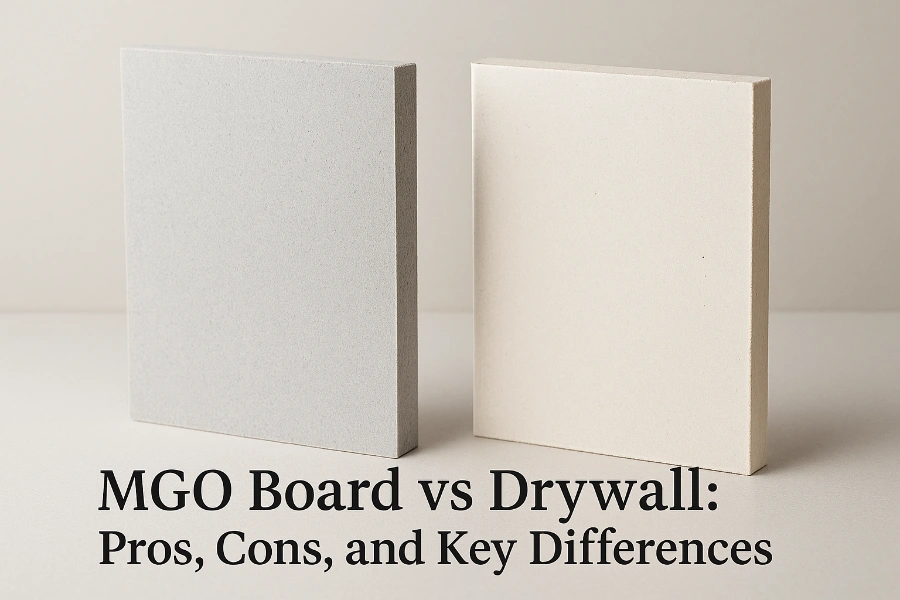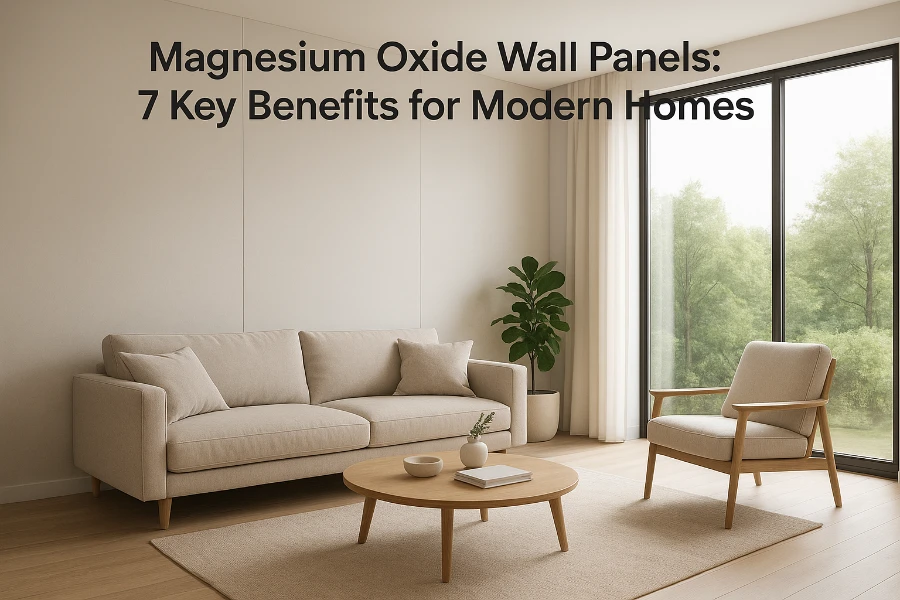Table of Contents
Introduction
Fire safety is a crucial aspect of modern construction. In residential, commercial, or industrial buildings, walls and partitions must slow the spread of flames to protect people and property. Fire resistant wallboard is designed specifically for this purpose, offering enhanced protection compared to ordinary boards.
Different types of fire resistant wallboards use various materials, each with its own performance, durability, and moisture resistance. Choosing the right board requires understanding these differences to meet both safety standards and project requirements.
What Is Fire Resistant Wallboard?
Fire resistant wallboard is a specialized type of construction panel designed to limit the spread of fire and provide extra time for evacuation in case of a fire emergency. Unlike regular drywall or wood panels, fire resistant wallboards are manufactured with materials that can withstand high temperatures for a prolonged period. Their primary function is not only to resist flames but also to prevent heat from quickly transferring through walls, which can be critical in protecting both lives and property.
The applications of fire resistant wallboard are broad. In residential buildings, fire resistant wallboards are often used in corridors, kitchens, utility rooms, and stairwells where fire risk is higher. In commercial spaces, offices, hotels, and retail stores rely on these boards for partitions, emergency exit routes, and areas with higher electrical loads. Industrial facilities, especially those handling flammable materials or high-heat processes, use fire resistant wallboards extensively to ensure compliance with safety regulations and to protect equipment and personnel.
Material composition varies depending on the type of fire resistant wallboard. Traditional gypsum boards are enhanced with fire-retardant additives, allowing them to resist flames for a specific period, usually up to 60–120 minutes under standard test conditions. Cement boards provide higher durability and moisture resistance, making them suitable for humid environments or exterior applications. Calcium silicate boards offer excellent thermal stability and fire performance, often used in high-temperature industrial settings. Magnesium oxide (MgO) boards combine fire resistance with moisture and mold resistance, as well as environmental friendliness, making them increasingly popular in modern construction. Fiber-reinforced boards add structural strength while maintaining fire-resistant properties, suitable for both interior and exterior partitions.
Understanding what fire resistant wallboard is and how it differs from ordinary panels is essential before making a selection. Not every wallboard labeled “fire resistant” will meet the same standards, and factors like fire rating, material composition, and installation environment all influence the actual performance of the wall. By carefully considering these aspects, architects, contractors, and building owners can ensure that their projects meet both safety requirements and long-term durability expectations.
Key Factors to Consider Before Choosing
Selecting the right fire resistant wallboard requires careful consideration of multiple factors. These factors determine not only how well the board will perform in a fire but also how it will hold up over time under different environmental conditions. Understanding these points is crucial for making an informed decision.
Fire Rating and Standards
One of the most important factors is the fire rating of the wallboard. Fire ratings indicate how long the board can withstand fire before failing. Ratings are often measured in minutes, such as 30, 60, 90, or 120 minutes, depending on testing standards. Common standards include UL (Underwriters Laboratories) in the United States, EN (European Norms) in Europe, and AS/NZS (Australian/New Zealand Standards) in Oceania. Before selecting a board, it is essential to verify that it meets the fire rating required by local building codes. Boards with certified fire ratings provide assurance that they have been tested under controlled conditions and can deliver reliable performance in real situations.
Material Composition
The materials used in fire resistant wallboards greatly affect their performance. Gypsum boards are widely used and cost-effective but usually require additives to enhance fire resistance. Cement boards and calcium silicate boards offer higher durability and resistance to moisture and heat, making them suitable for demanding environments. Magnesium oxide (MgO) boards provide excellent fire resistance while also offering protection against mold, moisture, and pests. Fiber-reinforced boards combine structural strength with fire-resistant properties, which can be advantageous in areas where both fire safety and mechanical stability are critical. Understanding the composition helps in selecting a board that matches the specific requirements of a project.
Moisture and Mold Resistance
Moisture resistance is another key consideration, especially in areas such as kitchens, bathrooms, basements, or industrial spaces where humidity levels can be high. A board that absorbs water easily can lose its fire resistance and structural integrity over time. Boards like MgO and cement-based panels provide superior moisture resistance compared to traditional gypsum boards. Mold resistance is also crucial, as mold growth can not only damage the board but also create health hazards for building occupants.
Cost vs. Performance
While high-performance fire resistant wallboards may cost more upfront, they often provide longer-lasting protection and lower maintenance costs over time. It is important to balance budget considerations with the desired fire rating, durability, and environmental conditions. Sometimes, a slightly more expensive board can deliver significantly better performance, making it a more cost-effective choice in the long run.
By considering fire rating, material composition, moisture and mold resistance, and cost-effectiveness, project planners can select the most suitable fire resistant wallboard for their needs. This careful evaluation ensures that the chosen boards will meet both safety requirements and long-term durability expectations, while also providing the best value for the investment.
Top 5 Fire Resistant Wallboard Choices
When it comes to fire resistant wallboards, there is no one-size-fits-all solution. Different materials offer varying levels of fire protection, durability, moisture resistance, and cost. Below are the top five choices commonly used in construction projects worldwide.
1. Gypsum Board (Fire-Rated Drywall)
Gypsum board, also known as fire-rated drywall, is one of the most widely used fire resistant wallboards. It consists primarily of gypsum, a naturally fire-resistant mineral, combined with paper facings and additives that enhance fire resistance. Gypsum boards are relatively affordable, easy to cut and install, and widely available in different thicknesses. They typically provide 30 to 60 minutes of fire protection when properly installed in wall assemblies.
While gypsum boards are effective in slowing the spread of fire, they are less resistant to moisture and impact compared to other options. In areas prone to humidity or heavy use, additional layers or alternative boards may be preferable.
2. Cement Board
Cement boards are composed of cement and reinforcing fibers, offering exceptional durability and fire resistance. These boards are often used in high-humidity areas such as bathrooms, kitchens, or industrial spaces because they do not absorb water easily and resist mold growth. Cement boards provide longer fire resistance compared to standard gypsum boards and maintain their structural integrity under high heat.
The main drawback of cement boards is their weight and difficulty in cutting and installation. They are more labor-intensive and require specialized tools, which can increase overall project costs.
3. Calcium Silicate Board
Calcium silicate boards are high-performance panels known for their thermal stability and excellent fire resistance. They can withstand extremely high temperatures without warping or losing strength, making them suitable for industrial applications and areas exposed to intense heat. In addition to fire resistance, these boards also offer good moisture resistance and long-term durability.
However, calcium silicate boards can be brittle and more expensive than gypsum or cement boards. Careful handling during transport and installation is necessary to avoid damage.
4. Magnesium Oxide (MgO) Board
Magnesium oxide boards are increasingly popular in modern construction due to their versatility and superior performance. MgO boards provide excellent fire resistance, often outperforming standard gypsum and cement boards in both fire rating and heat insulation. They are also highly resistant to moisture, mold, and pests, which makes them suitable for a wide range of environments including kitchens, basements, and commercial buildings.
Installation is relatively straightforward compared to cement or calcium silicate boards, and MgO boards are environmentally friendly, containing no harmful chemicals. While the cost may be higher than basic gypsum boards, their durability and multi-functional properties often justify the investment.
5. Fiber-Reinforced Board
Fiber-reinforced boards combine structural strength with fire resistance, making them suitable for areas that require both mechanical stability and protection against fire. These boards often include a mix of cement, fibers, and additives that improve impact resistance and prevent cracking. They can be used in both interior and exterior walls, and some variants provide additional moisture resistance.
The main consideration with fiber-reinforced boards is that installation may require specialized fasteners or techniques to ensure proper attachment and performance. Despite this, they offer a balanced solution for projects where fire safety and structural integrity are equally important.

Comparison of the 5 Options
Choosing the most suitable fire resistant wallboard requires evaluating multiple factors, as each type has its own advantages and limitations. The following comparison highlights the key differences in fire performance, durability, moisture resistance, installation, and cost.
Fire Performance
Gypsum boards typically provide 30–60 minutes of fire resistance, which is sufficient for many residential and commercial applications. Cement boards offer higher resistance, usually up to 90 minutes, while calcium silicate boards can withstand extreme temperatures for longer periods, making them ideal for industrial settings. Magnesium oxide boards provide excellent fire performance, often exceeding standard gypsum and cement boards, and are considered non-combustible under most testing standards. Fiber-reinforced boards also deliver strong fire resistance while maintaining structural integrity.
Durability and Moisture Resistance
In terms of durability, cement and calcium silicate boards are highly resistant to impact and wear, while gypsum boards are more prone to dents and damage. Moisture resistance varies significantly: gypsum boards are less suitable for humid environments unless specially treated, whereas MgO boards and cement-based boards excel in moisture-prone areas. Fiber-reinforced boards offer moderate moisture resistance combined with added strength, suitable for both interior and exterior applications.
Installation and Workability
Gypsum boards are lightweight, easy to cut, and simple to install, making them popular for fast construction projects. MgO boards also offer relatively easy installation with standard tools. Cement and calcium silicate boards are heavier and require more labor-intensive handling, which can extend project timelines. Fiber-reinforced boards may need specialized fasteners or installation techniques to ensure proper attachment and performance.
Cost-Effectiveness
Gypsum boards are the most affordable option, offering good fire protection for low- to mid-budget projects. Cement and calcium silicate boards are more expensive due to their material composition and installation requirements. Magnesium oxide boards are higher in initial cost but offer long-term benefits, including durability, moisture resistance, and multi-purpose use, making them cost-effective over time. Fiber-reinforced boards occupy a middle ground, providing both fire resistance and structural strength at a moderate price.
This comparison allows building owners, architects, and contractors to assess which board best meets their project requirements. By weighing fire resistance, durability, moisture protection, ease of installation, and budget, decision-makers can select the optimal wallboard for their construction needs.
Best Applications for Each Option
Understanding where each type of fire resistant wallboard performs best can help ensure safety, durability, and cost-efficiency in construction projects. Different boards are optimized for specific environments, and selecting the right one depends on factors such as fire risk, humidity, and usage frequency.
Gypsum Board
Gypsum boards are ideal for interior walls in residential and commercial buildings where moderate fire protection is sufficient. They are particularly suitable for living rooms, bedrooms, offices, and non-critical partitions. Due to their affordability and ease of installation, gypsum boards are commonly used in large-scale residential developments or office renovations. However, they should be avoided in high-moisture areas unless treated with moisture-resistant additives.
Cement Board
Cement boards are best suited for areas exposed to high humidity or potential water contact, such as bathrooms, kitchens, laundry rooms, and basements. Their combination of moisture resistance and fire protection makes them a reliable choice for commercial kitchens, industrial facilities, and utility spaces where walls are prone to both heat and moisture. Cement boards are also durable enough for exterior walls and areas that experience frequent wear and tear.
Calcium Silicate Board
Calcium silicate boards excel in industrial and high-temperature environments. They are commonly used in factories, power plants, and boiler rooms where extreme heat is present. Their high fire rating and excellent thermal stability make them suitable for protective enclosures, partitions, and ceilings in areas that must withstand prolonged exposure to high temperatures.
Magnesium Oxide (MgO) Board
Magnesium oxide boards are highly versatile, making them suitable for a wide range of applications. They are ideal for kitchens, basements, commercial interiors, schools, hospitals, and other areas where both fire resistance and moisture protection are important. MgO boards are also environmentally friendly and can be used in green building projects. Their combination of fire, moisture, and mold resistance makes them one of the most comprehensive options for modern construction.
Fiber-Reinforced Board
Fiber-reinforced boards are often used in locations where both structural strength and fire protection are required. They are suitable for interior and exterior walls, stairwells, corridors, and high-traffic areas. These boards are particularly beneficial in commercial and institutional buildings, such as schools, hospitals, and offices, where walls must endure physical impact while maintaining fire safety standards.
By understanding the ideal applications of each fire resistant wallboard, contractors and designers can match material selection to specific environmental conditions and project requirements. This ensures that each wall not only meets safety standards but also performs reliably over time.
Conclusion
Choosing the right fire resistant wallboard is essential for ensuring safety, durability, and efficiency in construction projects. Each type of board—gypsum, cement, calcium silicate, magnesium oxide, and fiber-reinforced—offers unique advantages and is suitable for specific applications. Gypsum boards provide an affordable and easy-to-install solution for general interiors, while cement and calcium silicate boards excel in high-moisture or high-temperature environments. Magnesium oxide boards stand out for their combination of fire resistance, moisture protection, and versatility, and fiber-reinforced boards balance structural strength with fire safety.
By carefully evaluating fire rating, durability, moisture resistance, installation requirements, and budget, project planners, architects, and building owners can select the most suitable wallboard for their needs. Comparing the top options side by side allows informed decision-making, ensuring that walls not only meet building codes but also provide long-term performance and peace of mind.
For those looking to implement high-quality fire resistant wallboards, consulting with a reliable supplier can help identify the best product for your specific project. Contact our team today to receive detailed technical guidance, product recommendations, and sample boards to ensure your construction meets the highest fire safety standards.
How to choose a reliable MGO board supplier: discover key merits of suppliers and magnesium oxide boards for safe, durable, and eco-friendly construction.
Compare MGO board vs drywall to understand their pros, cons, and key differences. Discover which wall material suits your project best.
Discover 7 key benefits of magnesium oxide wall panels for modern homes, from fire resistance and moisture protection to durability and eco-friendliness.




